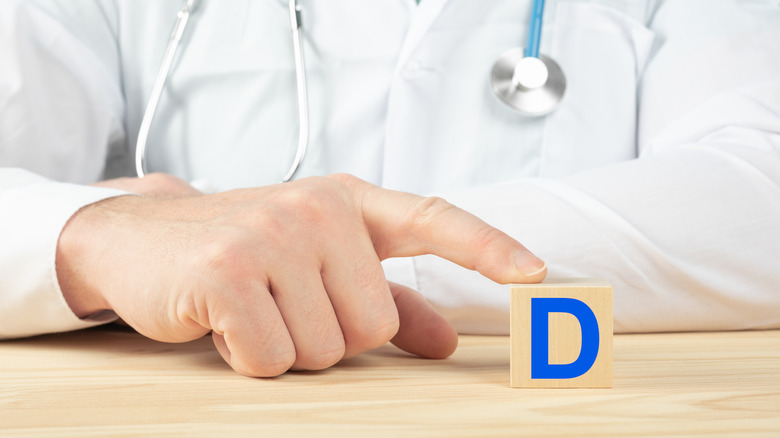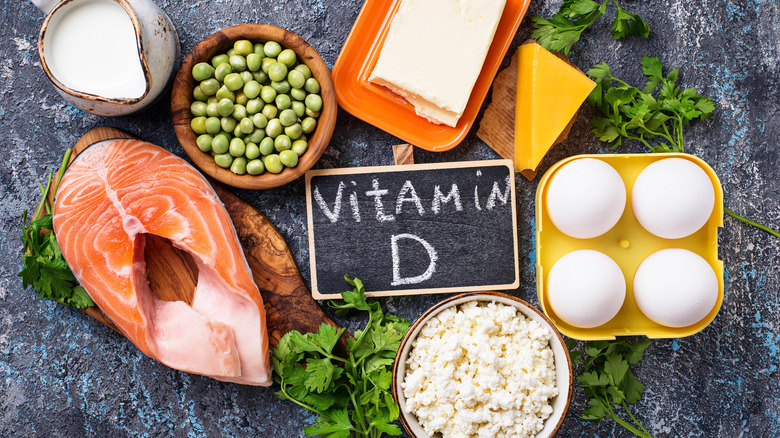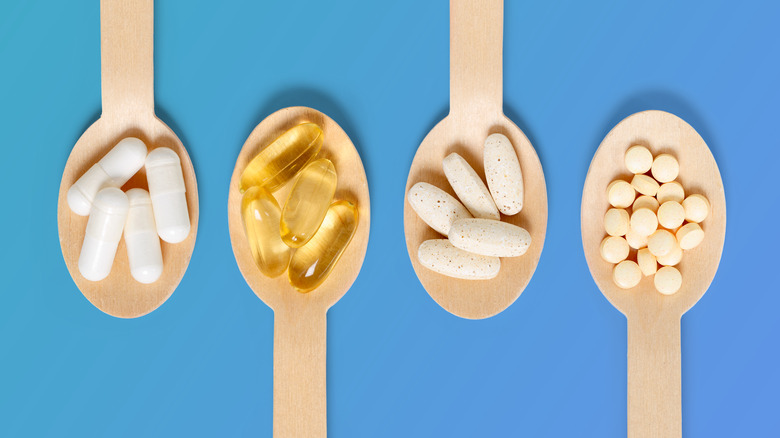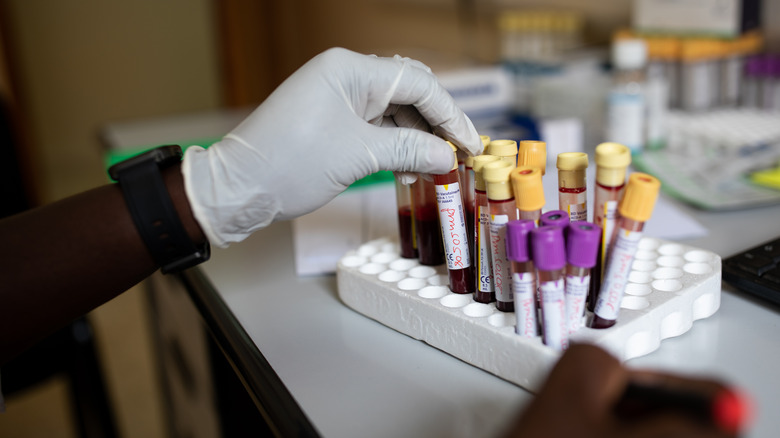Myths About Vitamin D That You Need To Stop Believing
Vitamin D plays an important role in many bodily functions; namely, immune system health, brain cell activity, and muscle function, per the Mayo Clinic. It also enables the body to properly absorb calcium, which is important for maintaining healthy bones. Insufficient levels of the vitamin are associated with numerous diseases and afflictions that can range from osteoporosis to rickets, cognitive decline, and multiple sclerosis.
This essential vitamin comes from a variety of sources, including food, sunlight, and supplements, explains Healthline. When exposed to sunlight, your body synthesizes the vitamin itself from the ultraviolet B (UVB) rays. To carry out this task properly, you need to spend up to half an hour in direct sunlight a few times a week, with around a third of your skin exposed and free of sunscreen. The vitamin can also be found in several different foods, namely salmon, beef liver, eggs, mushrooms, fortified cereals, yogurts, milk, and juices.
Harvard's T.H. Chan School of Public Health outlines the daily recommended amount of vitamin D, which is determined based on age. Adults between the ages of 19 and 70 should get 600 IU of vitamin D every day, while those over the age of 70 need 800 IU daily.
Since vitamin D is so important for the body, there is always plenty of information about the vitamin going around. However, you are also likely to run into a lot of misinformation. These are five myths about vitamin D you should be aware of.
Myth: You can get enough vitamin D through diet alone
Unfortunately, food sources don't typically contain enough vitamin D to reach daily recommendations, per Everyday Health. Some common vitamin-D-rich foods include eggs (44 IU per large egg) and fortified cereals (80 IU per serving). Healthline points out that a 3.5-ounce serving of salmon contains 526 IU of the vitamin, and a 3.5-ounce serving of tuna boasts 268 IU. A cup of soy milk may contain between 107 and 117 IU. Unless you consume large amounts of seafood, you can see that hitting the daily recommendation of 600 IU for adults between the ages of 19 and 70 is challenging.
Spokesperson for the Academy of Nutrition and Dietetics, Amy Kimberlain, explains that it is necessary to seek out other forms of vitamin D to ensure you are getting enough (via Everyday Health). "Fueling up with foods that naturally have vitamin D and those that are fortified vitamin D will provide some vitamin D; however, getting some of your vitamin D through sunlight and taking a supplement can help you reach sufficient levels," she states.
When it comes to sun exposure, aim for between 10 and 30 minutes per day, notes Healthline. After this time period, you are at risk for a sunburn and should apply sunscreen. If you decide to take a supplement as well, Mayo Clinic recommends choosing a daily multivitamin that contains vitamin D. Just make sure you don't exceed the upper limit of 4,000 IU per day.
Myth: You can safely exceed the daily recommended dose
Yale Medicine's Thomas Carpenter points out the common misconception that exceeding the daily recommended amount of vitamin D is safe. While some people may need to ingest large amounts of vitamin D to correct a deficiency, this is the exception, not the rule.
Since this vitamin is stored in fat, it is possible for smaller people to run out of room to store it (via Yale Medicine). If this happens, Carpenter says that "vitamin D goes into your blood and you may absorb too much calcium, creating a toxic situation. And it's unclear how long you have until you exceed the upper limits of vitamin D intake before it becomes dangerous." When buying vitamin D supplements, Carpenter advises not purchasing one that delivers more than the daily recommended amount.
Mayo Clinic outlines the common symptoms associated with vitamin D overdose to look out for if you don't heed the daily allowance. The result of vitamin D buildup in the blood is hypercalcemia, which can present as vomiting, excessive urination, and calcium stones in the kidneys. If you suspect vitamin D toxicity, you will need to contact your doctor immediately. Treatments can range from simply stopping vitamin D supplementation to the administration of IV fluids and steroid medications. Note that going slightly over the daily recommended amount likely won't cause issues — toxicity only occurs when the daily IU dosage hits the tens of thousands.
Myth: All vitamin D supplements are the same
Not all vitamin D supplements are created equal, according to MindBodyGreen. There is more than one type of vitamin D that is synthesized and sold in pill form, including D2 and D3. The main difference between the two is that the former is typically derived from plants while the latter comes from animal sources. However, vitamin D3 can now be extracted from lichen and algae as well.
When it comes to choosing between these two forms of vitamin D, you should always go for D3, which is more effective, stable, and bioactive (via MindBodyGreen). It does a far superior job of maintaining your vitamin D levels and is easily converted into a usable form of the vitamin, which was evidenced in a 2012 meta-analysis published in The American Journal of Clinical Nutrition. Another 2011 study published in The Journal of Clinical Endocrinology and Metabolism showed that vitamin D3 is 87% more potent than its counterpart in maintaining adequate concentrations of the vitamin in the body.
Not only is it important to pay attention to the type of vitamin D you're taking, you also need to take it in a way that boosts its effectiveness, according to MindBodyGreen. Since this vitamin is fat soluble, it needs to be ingested alongside a fat source to be absorbed properly during digestion. Alternatively, you can look for supplements that provide a fat source within the capsule, such as an oil, to assist in the absorption of the vitamin.
Myth: You should shoot for vitamin D levels of 30 ng/ml
Another common myth in circulation is how much vitamin D our bodies need, per MindBodyGreen. During blood analysis, vitamin D levels are measured in nanograms per milliliter (ng/ml) units. The minimum level of vitamin D needed for sufficiency is 30 ng/ml; however, this number has been confused with the optimum level of vitamin D.
Board-certified endocrinologist Brittany Henderson explains that 30 ng/ml "is the bare minimum level to avoid major issues known to occur with vitamin D deficiency, including bone issues and poor thyroid health," (via MindBodyGreen). Henderson adds, "Levels in the 50+ ng/ml range [are] imperative for immune health, bone health, and more."
Unfortunately, many adults aren't meeting the 30 ng/ml minimum, let alone reaching optimum levels of 50 ng/ml, according to a 2018 study published in the British Journal of Nutrition. Around 41% of U.S. adults have levels below 50 ng/ml, making them vitamin D insufficient. Additionally, about 29% of U.S. adults are classified as vitamin D deficient, with levels below 30 ng/ml. These percentages increase, depending on a variety of risk factors, including sex, age, race, physical activity, education, obesity status, and whether or not the individual smokes or drinks alcohol. Researchers point out that ensuring daily sun exposure and supplementing with vitamin D will go a long way in changing these numbers.
Myth: Vitamin D is proven to prevent cancer
While clinical trials have studied a potential link between vitamin D deficiency and the development of cancer, there is no proof that vitamin D can help prevent cancer, explains the National Cancer Institute. One specific 2019 study, known as the Vitamin D and Omega-3 Trial (VITAL), looked at whether vitamin D supplementation reduced the incidence of invasive cancer in individuals above the age of 50, over the course of five years. However, the percentage of participants diagnosed with cancer during the course of the study was nearly the same in both the supplementation and the placebo group, showing that vitamin D may not be effective in reducing the incidence of cancer. That being said, further research is necessary to determine whether vitamin D is linked to a reduction in cancer deaths after diagnosis.
Harvard's T.H. Chan School of Public Health also points out the important role of vitamin D in immune function. Low levels of the vitamin can increase one's susceptibility to the flu and the common cold in the winter months. Some studies have also found a link between vitamin D deficiency and the risk of developing multiple sclerosis (MS).






